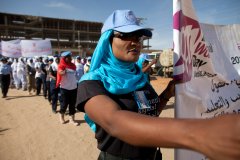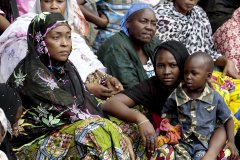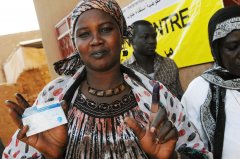Gender Issues Showlist
Women, Peace & Security
UNSCR 1325 calls on all parties to: protect and respect the rights of women and girls in conflict & post-conflict; increase women participation in all conflict resolution, peacekeeping and peace-building & to end impunity by prosecuting perpetrators of sexual and other violence on women and girls
index.php?option=com_content&view=category&id=56&Itemid=1913
Human Rights of Women
Thirty six years after the adoption of CEDAW, many women and girls still do not have equal opportunities to realize rights recognized by law. Women are denied the right to own property or inherit land. They face social exclusion, “honor killings”, FGM, trafficking, restricted mobility, early marriage,...
index.php?option=com_content&view=category&id=44&Itemid=1908
Violence Against Women
Violence against women is the most shameful human rights violation. Gender based violence not only violates human rights, but also hampers productivity, reduces human capital and undermines economic growth. It is estimated that up to 70 per cent of women experience violence in their lifetime
index.php?option=com_content&view=category&id=69&Itemid=1912
Political Participation & Leadership
Where women are fully represented, societies are more peaceful and stable. Women political participation is fundamental for gender equality and their representation in positions of leadership must be a priority for all Africans governments.
index.php?option=com_content&view=category&id=65&Itemid=1911
Latest News
- COTE D'IVOIRE: South-South Meeting to Promote Gender Equality and Combat Deforestation
- RWANDA: Rwanda Set to Launch Cervical Cancer Elimination Plan
- NIGERIA: Over 5,000 Nigerian Women Stranded in Iraq - Govt
- SUDAN: Healthcare Collapse Threatens Pregnant Women in Sudan's Sharg El Nil
- GHANA: President Nominates 12 More Ministers
- Senegal: Parliamentary election 2024
- Mauritius: Parliamentary election 2024
- Ghana: Presidential and Parliamentary Elections
- Botswana: Parliamentary elections 2024
- Algeria: Presidential Election 2024
Abortion Care in North Africa
By Haleemah Shajira
Across Northern Africa, there are various legalities and practices surrounding abortion access. The Maputo Protocol, which was adopted in Maputo, Mozambique in 2003, calls for women’s rights and girls’ rights. Countries are at varying stages of signing and ratifying the Maputo Protocol.
-
Algeria: Ratified (2016). However, abortion is not considered a human right in certain cases, such as rape, sexual assuslt, and incest, in disagreement with the Maputo Protocol.
-
Mauritania: Signed & Ratified (2005), although abortion is still a legal crime.
-
Sudan: Signed (2008) & Not Ratified
-
Tunisia: Signed (2015) & Ratified (2018)
-
Egypt, Morocco, Libya: Not Signed & Not Ratified
Countries also have differing laws, both formally and informally, around abortion. In Libya and Morocco, women are legally permitted to seek abortion care “in cases of a risk to the pregnant woman’s physical health.” Algeria and Morocco allow abortion when there is “a risk to the pregnant woman’s mental health.” When there is risk of fetal impairment, Tunisia and Morocco permit abortion. In cases of rape, Moroccan and Sudanese laws allow abortion.
In the MENA (Middle East and North Africa) region, Islamic practice also influences abortion access. Islamic experts have generally considered abortion permittable when a pregnancy endangers a woman’s life, but not in other cases. Experts have debated the allowable timelines for abortion under Islam.
Conservative mindsets further limit abortion access, with conservative governments generally opposing abortion and female autonomy. Additionally, there is limited female representation in governments. The limited presence of women in government and politics prevents women’s issues being analyzed and supported by women. In February 2019, women composed 24.3% of national parliamentarians in the world, and only 12 Heads of Government and 11 Head or State were female as of June 2019. Low female representation is seen across other governmental levels. As such, women are not able to have their voices heard and represented at a ratio that matches the actual population gender ratio, which, as of 2018, was 48.2% female in MENA.
In 2017, the Trump administration instituted the “global gag rule.” The gag rule severely impacts global access to maternal, childcare, abortion, and reproductive health resources, as it prevents United States funding to go towards any NGO providing abortions, or even advide regarding abortions. With abortions, and the discussing of abortion as an option, equating to hindered funding, this gag rule restricts family planning around the globe. With the United States discontinuing financial support, the United Nations Population Fund (UNFPA) estimates hundreds of millions of USD lost to family planning and maternal care. Contrary to the Trump adminisrtation’s approach, research finds that abortion rates decrease as access to legal and safe abortion care increases.
Abortion Statistics: Globally and Regionally
The World Health Organizaton, in 2008, estimated “the yearly total of unsafe abortions to be [...] 900,000 in Northern Africa (Maghreb), causing 1,500 annual maternal deaths.” The annual abortion rate globally has decreased for women of reprodutive age (15 - 44 years old) from 4% between 1990 - 1994 to 3.5% in between 2010 - 2014. However, this data is affected by geographical region, with developed countries seeing a decrease in abortion rates, while developing countries experience less significant rate variation.
In developed countries, from 1990 - 1994 to 2010 - 2014, the pregancies that ended with abortion rose from 21% to 24%. In Africa from 2010 - 2014, the abortion rate was 3.4%, which met the global decrease from the abortion rate two decades prior. However, Northern Africa’s abortion rate was slightly higher, at 3.8%, and this region has seen a near stagnant aborton rate since the 1990s. While global data looks at abortions among women of reproductive age, it is limited in scope, as women are capable of and do get pregnant and have abortions below and above the age range of 15 - 44 years old.
There is correlation between unsafe abortion and restrictive abortion polices and care, stigma, and low affordability. These factors linked to unsafe abortions, in general, are seen in greater concentration in deloping countries compared to developed countries. Furthermore, countries with greater regard for reproductive autonomy tend to spread information regarding the legality of abortion, as well as the public and mental health benefits, at high, systemic levels, such as government and medical institutions.
Social Factors
A study published in the Health and Human Rights Journal found the following social factors to significantly influence abortion access in the MENA region: social class, marital status, income, age, and education. Tunisia, where the Arab Spring began, and Morocco provide case examples into these social factors correlating to abortion.
In Tunisia, there is limited public sector abortion access due to financial restraignts on healthcare. Beyond legislation and wide-held beleiefs, women are being denied abortions due to monetary reasonss. This demonsrates the influence social status and income have over the ability to access abortion care. When a woman has higher income or social status, she is more likely to be able to pay for a safe abortion compared to women who have limited personal means to seek healthcare.
Morocco’s abortion access is influenced by a significant class divide and stigma based on maritial status. However, research shows that abortion is a common practice among local Moroccan health providers, so long as women are situated with favorable status, such as wealth and marriage. In Morocco’s large cities, married women are generally able to easily access abortion doctors, in contrast with unmarried women with minimal wealth. “Many such women will therefore try to abort through more or less traditional methods, including herbal remedies, mechanical methods, and cocktails of various biomedicines.” These methods endanger the woman’s own life, as well as the fetus, which can cause lasting, even life-long health complications. Women who cannot afford a medical abortion and either choose to not or are unsuccessful in self-aborting can receive support from nongovernmental orgnizations (NGOs) focused on supporting unmarried women. Such NGOs are working to improve the rights of unmarried women who become pregnant and are mothers, as they challenge the traditional Moroccan legislation that fails to provide equitable protection and support to marginalized women.
The Arab Spring
The Arab Spring began in 2010 in Tunisia, and spread throughout the MENA region as countries and peoples protested governments. Women played a prominent role, spreading their voices as countries sought freedoms. Tawakkol Karman, Nobel Peace Prize winner, spoke of women working “to win their rights in a society dominated by the supremacy of men,” demonstrating women striving for their autonomy within a patriarchal community. Meanwhile, many women were subjected to sexual violence, assault, and rape, with perpetrators being men attempting to silence female advocates and take away theirr ‘honor,’ which holds considerable value in society. Rape served as a method to marginalize women, as they were then stigmatized and considered of lower status. The further the blow, many survivors were then unable to access abortion due to limited legal and societal factors. In Libya, abortion is illegal and under certain circumstances, a woman can be immprisioned if she attempts to self-abort.
Following the initial changes seen from the Arab Spring, there has been mixed progress, with countries seeming to have taken a one step forward and two steps back in citizens’ claims on autonomy and in fights against corruption. Initial progress remains marred with lasting political and leadership unrest that has yet to settle.
Women are seeing varying abilities to their right to autonomy and reproductive justice. However, the Arab Spring and increased abortion access in some reagions are demonstrating the strength of women as they fight for their rights.
Reproductive Justice
Susheela Singh, Guttmacher Institute’s international research vice president, stated, “Improved contraceptive use, and in turn, declines in unintended pregnancy rates are the likely driver behind the worldwide decline in abortion rates.” Improving abortion access is only a fraction of reproductive justice, which also calls for women to have autonomy over choosing pregancies and childbirthing. Therefore, as Singh touches on, access to contraception and family planning education and resources will improve women’s reproductive rights. Signh adds, “Most women who have an abortion do so because they did not intend to become pregnant in the first place. Meeting the need for contraception is critical to bringing down rates even further.” No woman seeks abortion care for the thrill of it. Rather, it is a decision made due to circumstances, health, and oppression of women and the female body. When abortion is legal, women at the least have the comfort of knowledge that they are not breaking the law and are much more likely to abort in safe conditions, rather than life-threatening conditions. And in a patriarchal world where male bodies are valued above all others, at the very least women should not have to choose to abort in life-threatening conditions when her alternative is knowing she faces a life-threatening pregnancy that will cause herself and her child immense suffering.
Women know the choices they face. They fight for their rights and safety. It is time for everyone to recognize these choices and uphold reproductive justice. Women have the right to family planning. Women have the right to autonomy and self-decision-making. Women have the right to abortion care.
*Please note this post utilizing binary language in accordance with the majority of research and news articles. However, the author recognizes this is limiting and fails to include all individuals and identities affected by these topics.





